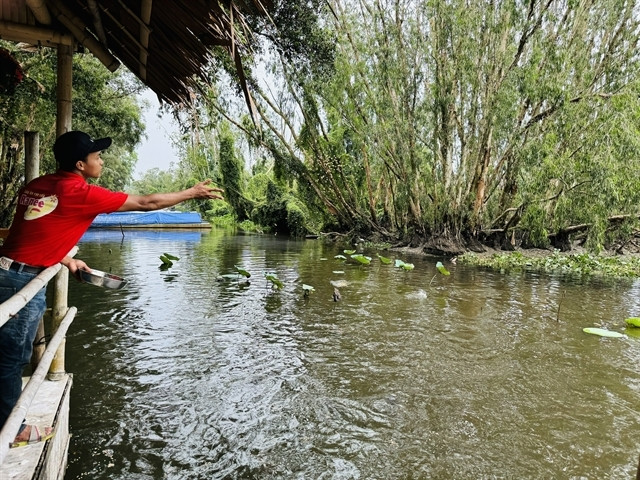 |
| Lê Hoàng Ân, director of the Trà Sư Cajuput Forest Tourism Site, which pays great attention to conserving its large variety of animals and plant species. Photo courtesy of Lê Hoàng Ân |
The 845ha Trà Sư cajuput forest in An Giang Province’s Tịnh Biên Town is an ecologically important area with a wide variety of animals and plants.
The tourism site there is a popular destination that offers visitors a number of nature-centric activities such as river tours, bird-watching and agro-tourism.
Lê Hoàng Ân, director of the site, speaks to Việt Nam News about preserving biodiversity, and how tourism activities serve this goal.
What is the Trà Sư cajuput forest’s biodiversity like?
The Trà Sư cajuput forest has extremely rich flora and fauna, with some 70 species of water birds, mostly sparrows, white storks and egrets. There are two very rare and endangered bird species: Indian stork and snake-necked stork.
There are also 11 species of mammals, 20 species of reptiles, five species of frogs, and 23 species of fish.
It also has 140 plant species belonging to 52 families and 102 genera, including 22 species of trees, 25 species of shrubs, 10 species of vines, 70 species of grass, 13 aquatic species, 78 medicinal species, and 22 ornamental species, according to statistics from the An Giang Forest Protection Department.
What are some of the conservation activities undertaken in the forest area?
The Trà Sư Cajuput Forest Tourism Site considers forest preservation and developing biodiversity among the top priorities in its business operations. We protect the natural beauty of the forest, not only to serve eco-tourism but also for research purposes and protecting the environment.
Our conservation work is based on the guidelines issued by the Department of Agriculture and Rural Development and the Forest Protection Department.
We have set up patrol teams to watch out for bird poaching, electrofishing, wild bee hunting, illegal logging, and forest fires. We are equipped with professional firefighting equipment and tools.
We release fish into the area as feed for birds but also to foster aquatic life.
We plant trees and regulate the amount of water in the cajuput forest based on local authorities’ instructions.
The Trà Sư Cajuput Forest Tourism Site receives a great deal of support from authorities for both tourism development and the conservation of flora and fauna.
We put up signs to tell locals they are not allowed to hunt or fish in the forest. Locals mostly cooperate fully with us, but there are a few cases of poaching.
 |
| A staff member of the site feeds fish in the river. The site's conservation activities include caring for animals and trees, and preventing poaching and illegal logging. Photo courtesy of Lê Hoàng Ân |
How do you juxtapose the task of conservation with your business goals?
We are an eco-tourism site, and so we do business with the ecosystem.
To protect the Trà Sư Cajuput Forest, the management must also be "eco-friendly" as we have to utilise the natural resources in a careful and sustainable way while ensuring that these resources and characteristics like trees, fishes and birds are maintained.
Harnessing these resources and building infrastructure for tourism development need to be done in a modern way while still keeping the wild, untouched beauty of nature.
This is also true of our investments in tourism activities. They create our own style and a sense of modernity, but also reflect respect for nature and an understanding of why it needs to be protected, both by us and tourists coming here.
This bestows on us rich and unique cultural values, helps us attract tourists from Việt Nam and other countries and remain true to our motto of “green, clean and beautiful”.
How do the tourism activities here affect the goal of protecting biodiversity?
In a way, the eco-tourism activities at the Trà Sư cajuput forest are meant for visitors who care for nature and eco-systems. Visitors here cannot only look at the beautiful plants and animals, but also learn more about them.
Thus, they are not only enjoying nature, but also gaining a better understanding and appreciation of nature and why it needs to be preserved, which might motivate them to take steps to protect nature.
One noteworthy thing is that we often have educational trips for young school students.
The kids get to learn more about the aquatic birds in the places they live and the sort of dangers they face, both in the wild and from human activities. This inspires love for the birds and nature in general.
Through trips here, students not only learn to appreciate nature, but also realise that they are all pieces of a puzzle and everyone has a responsibility towards the sustainability of the cajuput forest. - VNS